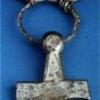Sign in to follow this
Followers
0

Leather Casing for a Hip Flask?
By
Ozmeath, in Purses, Wallets, Belts and Miscellaneous Pocket Items

By
Ozmeath, in Purses, Wallets, Belts and Miscellaneous Pocket Items